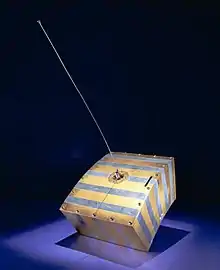PSAT-2
PSAT-2 is an experimental amateur radio satellite from the U.S. Naval Academy, which was developed in collaboration with the Technical University of Brno in Brno, Czech Republic. AMSAT North America's OSCAR number administrator assigned number 104 to this satellite; in the amateur radio community it is therefore also called Navy-OSCAR 104, short NO-104.
| Mission type | Communications |
|---|---|
| Operator | U.S. Naval Academy |
| COSPAR ID | 2019-036R[1] |
| SATCAT no. | 44357 |
| Mission duration | 1 year, 7 months and 10 days |
| Spacecraft properties | |
| Bus | CubeSat (1.5U) |
| Launch mass | 2 kilograms (4.4 lb) |
| Start of mission | |
| Launch date | 25 June 2019, 06:30 UTC |
| Rocket | Falcon Heavy |
| Launch site | Kennedy LC-39A[2] |
| Contractor | SpaceX |
| Orbital parameters | |
| Reference system | Geocentric |
| Regime | Low Earth |
| Semi-major axis | 6,941.0 kilometres (4,312.9 mi) |
| Perigee altitude | 309.8 kilometres (192.5 mi) |
| Apogee altitude | 831.1 kilometres (516.4 mi) |
| Inclination | 28.5306° |
| Period | 95.9 minutes |
| Epoch | 3 February 2020[3] |
| Transponders | |
| Band | FM |
Mission
PSAT-2 was launched on June 25, 2019 with a Falcon Heavy from Kennedy Space Center, Florida, United States, as part of Mission STP-2 (Space Test Program 2) as one of 24 satellites.
Frequencies
The following frequencies for the satellite were coordinated by the International Amateur Radio Union:
See also
References
- Jonathan McDowell. "Launch Log". Jonathan's Space Page. Retrieved 3 February 2020.
- Gunter Dirk Krebs. "PSat 2 (Navy-OSCAR 104 / NO 104)". Gunter's Space Page. Retrieved 3 February 2020.
- n2yo.com. "OBJECT U". Retrieved 3 February 2020.
External links
- PSAT2 - Amateur Radio Communications Transponders. APRS
- PSAT2 SSTV camera and transponder homepage, pictures and tlm archive.
This article is issued from Wikipedia. The text is licensed under Creative Commons - Attribution - Sharealike. Additional terms may apply for the media files.

